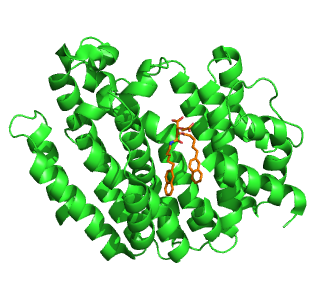Geranylgeranyl pyrophosphate synthase is an enzyme that in humans is encoded by the GGPS1 gene. [5] [6] [7]
Geranylgeranyl pyrophosphate synthase is an enzyme that in humans is encoded by the GGPS1 gene. [5] [6] [7]
This gene is a member of the prenyltransferase family and encodes a protein with geranylgeranyl diphosphate (GGPP) synthase activity. The enzyme catalyzes the synthesis of GGPP from farnesyl diphosphate and isopentenyl diphosphate. GGPP is an important molecule responsible for the C20-prenylation of proteins and for the regulation of a nuclear hormone receptor. Alternate transcriptional splice variants, encoding different isoforms, have been characterized. [7]
Much like its homolog farnesyl diphosphate synthase, GGPS1 is inhibited by bisphosphonate compounds. [8]
Mutations in both copies of this gene have been associated with a syndrome of muscular dystrophy, hearing loss and ovarian insufficiency. [9]
Farnesyl pyrophosphate (FPP), also known as farnesyl diphosphate (FDP), is an intermediate in both the mevalonate and non-mevalonate pathways used by organisms in the biosynthesis of terpenes, terpenoids, and sterols.
Geranylgeranyl pyrophosphate is an intermediate in the biosynthesis of diterpenes and diterpenoids. It is also the precursor to carotenoids, gibberellins, tocopherols, and chlorophylls.
Geranylgeranyltransferase type 1 or simply geranylgeranyltransferase is one of the three enzymes in the prenyltransferase group. In specific terms, Geranylgeranyltransferase adds a 20-carbon isoprenoid called a geranylgeranyl group to proteins bearing a CaaX motif: a four-amino acid sequence at the carboxyl terminal of a protein. Geranylgeranyltransferase inhibitors are being investigated as anti-cancer agents.

Rab geranylgeranyltransferase also known as (protein) geranylgeranyltransferase II is one of the three prenyltransferases. It transfers (usually) two geranylgeranyl groups to the cystein(s) at the C-terminus of Rab proteins.
Geranylgeranylation is a form of prenylation, which is a post-translational modification of proteins that involves the attachment of one or two 20-carbon lipophilic geranylgeranyl isoprene units from geranylgeranyl diphosphate to one or two cysteine residue(s) at the C-terminus of specific proteins. Prenylation is thought to function, at least in part, as a membrane anchor for proteins.

Squalene synthase (SQS) or farnesyl-diphosphate:farnesyl-diphosphate farnesyl transferase is an enzyme localized to the membrane of the endoplasmic reticulum. SQS participates in the isoprenoid biosynthetic pathway, catalyzing a two-step reaction in which two identical molecules of farnesyl pyrophosphate (FPP) are converted into squalene, with the consumption of NADPH. Catalysis by SQS is the first committed step in sterol synthesis, since the squalene produced is converted exclusively into various sterols, such as cholesterol, via a complex, multi-step pathway. SQS belongs to squalene/phytoene synthase family of proteins.

Dimethylallyltranstransferase (DMATT), also known as farnesylpyrophosphate synthase (FPPS) or as farnesyldiphosphate synthase (FDPS), is an enzyme that in humans is encoded by the FDPS gene and catalyzes the transformation of dimethylallylpyrophosphate (DMAPP) and isopentenyl pyrophosphate (IPP) into farnesylpyrophosphate (FPP).
In enzymology, a geranyltranstransferase is an enzyme that catalyzes the chemical reaction

Protein farnesyltransferase/geranylgeranyltransferase type-1 subunit alpha is an enzyme that in humans is encoded by the FNTA gene.

Decaprenyl-diphosphate synthase subunit 1 is an enzyme that in humans is encoded by the PDSS1 gene.

Dehydrodolichyl diphosphate synthase is an enzyme that in humans is encoded by the DHDDS gene.

Polyprenyl synthetases are a class of enzymes responsible for synthesis of isoprenoids. Isoprenoid compounds are synthesized by various organisms. For example, in eukaryotes the isoprenoid biosynthetic pathway is responsible for the synthesis of a variety of end products including cholesterol, dolichol, ubiquinone or coenzyme Q. In bacteria this pathway leads to the synthesis of isopentenyl tRNA, isoprenoid quinones, and sugar carrier lipids. Among the enzymes that participate in that pathway, are a number of polyprenyl synthetase enzymes which catalyze a 1'4-condensation between 5-carbon isoprene units. It has been shown that all the above enzymes share some regions of sequence similarity. Two of these regions are rich in aspartic-acid residues and could be involved in the catalytic mechanism and/or the binding of the substrates.
Geranylfarnesyl diphosphate synthase is an enzyme with systematic name geranylgeranyl-diphosphate:isopentenyl-diphosphate transtransferase . This enzyme catalyses the following chemical reaction
Hexaprenyl diphosphate synthase is an enzyme with systematic name geranylgeranyl-diphosphate:isopentenyl-diphosphate transferase . This enzyme catalyses the following chemical reaction
Hexaprenyl-diphosphate synthase is an enzyme with systematic name (2E,6E)-farnesyl-diphosphate:isopentenyl-diphosphate farnesyltranstransferase . This enzyme catalyses the following chemical reaction
All-trans-nonaprenyl-diphosphate synthase is an enzyme with systematic name geranyl-diphosphate:isopentenyl-diphosphate transtransferase . This enzyme catalyses the following chemical reaction
Ditrans,polycis-polyprenyl diphosphate synthase is an enzyme with systematic name (2E,6E)-farnesyl-diphosphate:isopentenyl-diphosphate cistransferase . This enzyme catalyses the following chemical reaction

All-trans-octaprenyl-diphosphate synthase is an enzyme with systematic name (2E,6E)-farnesyl-diphosphate:isopentenyl-diphosphate farnesyltranstransferase . This enzyme catalyses the following chemical reaction
Squalene synthase EC (SQS) and Phytoene synthase EC (PSY) are enzymes that share a number of functional similarities. These similarities are also reflected in their primary structure. In particular three well conserved regions are shared by SQS and PSY; they could be involved in substrate binding and/or the catalytic mechanism. SQS catalyzes the conversion of two molecules of farnesyl diphosphate (FPP) into squalene. It is the first committed step in the cholesterol biosynthetic pathway. The reaction carried out by SQS is catalyzed in two separate steps: the first is a head-to-head condensation of the two molecules of FPP to form presqualene diphosphate; this intermediate is then rearranged in a NADP-dependent reduction, to form squalene:

Bisphosphonates are an important class of drugs originally introduced about half a century ago. They are used for the treatment of osteoporosis and other bone disorders that cause bone fragility and diseases where bone resorption is excessive. Osteoporosis is common in post-menopausal women and patients in corticosteroid treatment where biphosphonates have been proven a valuable treatment and also used successfully against Paget's disease, myeloma, bone metastases and hypercalcemia. Bisphosphonates reduce breakdown of bones by inhibiting osteoclasts, they have a long history of use and today there are a few different types of bisphosphonate drugs on the market around the world.
| | This article on a gene on human chromosome 1 is a stub. You can help Wikipedia by expanding it. |